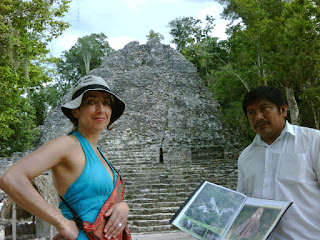The wind blowing in the palm trees around us.
A dog barking occasionally.
Crickets. Bats. Heat.
I am wearing only my underwear and feel a little hot. The temperature is going slowly down in the peaceful night, though.
Moni is starting to read her second novel in this trip. She can read for hours in a row. Wish I could.
The day was cloudy and hot: perfect for a trip to an archaeological site.
We must confess our ignorance: no idea that Coba even existed. When I heard it was not far from our hotel, I thought: "Is that true? Wasn't Coba in Honduras?"
The answer is: Copal is in Honduras and Coba in the Yucatan peninsula. Ok!
We were very lucky. We found a Mayan guide, Julio. I was surprised how many mistakes he made in Spanish. I guess Julio's Spanish was like my English. He said "la mapa", "el ciudá", "el mano". He spoke Maya with the other guides. Maya is an everyday language here, and no doubt it is Julio's first language.
Julio says Coba was the second largest, and second most important city in the old Mayan world after Tikal, in Guatemala. Most important even than Chichén Itzá. (I will have to check on that information.) Then, why do we hear so little about Coba in comparison with Chichen Itza? (I will have to check that also.)
There was a lot of walking to be done. Many tourists rented bikes or what the locals call a "taxi" which is a tricycle made of a bike with a cart in the front that can carry up to three people. In Mexico City those tricycles are very used to carry staples, sodas, tamales, etc., but the ones that carry people are very different. I had never seen those tricycles used as "taxis". It was funny.
We walked like two miles in the hot forest to reach the scattered pyramids, and meanwhile Julio gave us botanical explanations. He warned us about a tree that is poisonous, and the tree that is the antidote. If you see one, the other will always be near. The antidote tree has a red bark which peels very easily. The locals call it "the tourist tree" because it looks like a sunburnt tourist who is peeling.
There is another tree whose bark is white and pink but if you touch it your fingers turn yellow. Of course, it was used as a pigment in ancient times.
The most impressive of all the trees was the ceiba. It always has four roots which are directed towards the four cardinal points: one towards the north, one towards the south, one towards the east, and one towards the west. The tree is hollow (Julio tapped on them to prove it) and very tall, which is why it was used to make drums and canoes. Ceiba had also a mythological significance for Mayans, who were very aware of cardinal points, and thought the roots of the tree reached the underworld.
Julio also showed us bees without stings. They are very small and make their bee-hives into the trees. If you want to take their honey, you need to make a hole in the tree.
We reached the last pyramid, which is one of the tallest in the Yucatan peninsula, and Julio said goodbye (after collecting US$30, of course). We climbed the 120 steps, and had a wonderful view: other pyramids, a lake, the big forest, and lots of very small tourists wandering everywhere.
The place was crowded. We were so tired that we hired a "taxi" to take us back. We were driven at a fast speed (20 miles per hour or more?) among lots of pedestrians and bikers on a narrow and sandy road. I asked Pedro if there had been any accidents and he said no. It was refreshing to have the cool wind on our faces, though. We arrived at the entrance with no fatalities. Pedro was smiling. We were smiling. We had a really good time.


No hay comentarios:
Publicar un comentario